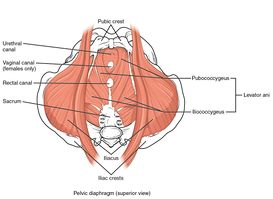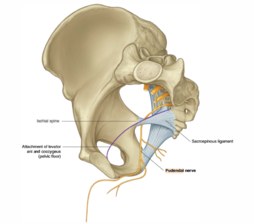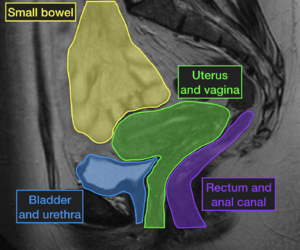Obstructed Defecation Syndrome: Difference between revisions
m (Grammar correction, Added headings, texts, references) |
m (Added text, reference, grammar correction and hyperlinked references) |
||
| Line 4: | Line 4: | ||
== Introduction == | == Introduction == | ||
Obstructed defecation syndrome is a pelvic floor disorder<ref name=":2">Rao SS, Go JT. Treating pelvic floor disorders of defecation: management or cure?. Current gastroenterology reports. 2009 Aug;11(4):278-87. | Obstructed defecation syndrome (ODS) is a pelvic floor disorder<ref name=":2">Rao SS, Go JT. [https://link.springer.com/article/10.1007/s11894-009-0041-3 Treating pelvic floor disorders of defecation: management or cure?.] Current gastroenterology reports. 2009 Aug;11(4):278-87.</ref> characterized by constipation with straining during defecation, incomplete evacuation and the need for digital support. It consists of structural disorders such as rectocele rectal mucosal intussusception, solitary rectal ulcer syndrome, rectocele, enterocele, or descending perineum syndrome and functional disorders such as dysynergy defecation.<ref name=":2" /><ref>Ascanelli S, Portinari M, Canella M, Solari S, Dall’Omo F, Danese S, De Troia A, Carcoforo P. [https://link.springer.com/article/10.1007/s10151-020-02381-9 Obstructed defecation syndrome associated with paradoxical puborectalis contraction: osteopathic treatment versus anal biofeedback. Results of a pilot study.] Techniques in Coloproctology. 2021 May;25:589-95.</ref>ODS occur significantly more frequently in women than in men. Increases with advancing age in both sexes.<ref>Siproudhis L, Lehur PA. [https://link.springer.com/chapter/10.1007/978-3-662-53210-2_11 Defecation disorders.] Coloproctology. 2017:121-33.</ref> | ||
== Clinical Anatomy and | == Clinical Anatomy and Physiology == | ||
[[File:1115 Muscles of the Pelvic Floor.jpg|thumb|273x273px]] | [[File:1115 Muscles of the Pelvic Floor.jpg|thumb|273x273px]] | ||
[[File:Pudendal Nerve.png|thumb|254x254px|Pudendal nerve]] | [[File:Pudendal Nerve.png|thumb|254x254px|Pudendal nerve]] | ||
| Line 13: | Line 13: | ||
The pudendal nerve innervates the external anal sphincter and part of the puborectalis muscle, with frequent and prolonged straining that may stretch the pudendal nerve causing [[Pudendal Neuralgia|pudendal neuropathy]]. | The pudendal nerve innervates the external anal sphincter and part of the puborectalis muscle, with frequent and prolonged straining that may stretch the pudendal nerve causing [[Pudendal Neuralgia|pudendal neuropathy]]. | ||
While we have voluntary control over the external anal sphincter the internal anal sphincter muscles are involuntary muscles affected by the rectum, it is relaxed if the rectum filled with stool and vice versa, so the sensitivity of the rectum is important for normal physiology. | While we have voluntary control over the external anal sphincter the internal anal sphincter muscles are involuntary muscles affected by the rectum, it is relaxed if the rectum filled with stool and vice versa, so the sensitivity of the rectum is important for normal physiology.<ref name=":3">Poylin V, Cataldo TE. Anal physiology: [https://link.springer.com/chapter/10.1007/978-3-319-25970-3_3 the physiology of continence and defecation. The ASCRS Textbook of Colon and Rectal Surgery.] 2016:37-44.</ref> | ||
During normal defecation, the relaxation of the anal sphincters and the puborectalis muscle allows the anorectal angle to widen and the perineum to descend. Concurrently, the voluntary effort of bearing down increases the intra-abdominal pressure. These movements (mixed voluntary and involuntary movements) enable the development of a stripping wave which moves the stool from the rectum and causes the relaxation pelvic floor muscles and the anus, resulting in stool evacuation.<br> | During normal defecation, the relaxation of the anal sphincters and the puborectalis muscle allows the anorectal angle to widen and the perineum to descend. Concurrently, the voluntary effort of bearing down increases the intra-abdominal pressure. These movements (mixed voluntary and involuntary movements) enable the development of a stripping wave which moves the stool from the rectum and causes the relaxation pelvic floor muscles and the anus, resulting in stool evacuation.<ref name=":3" /><br> | ||
== Mechanism of Injury / Pathological Process == | == Mechanism of Injury / Pathological Process == | ||
In general the pathogeneses of ODS varying from: | In general the pathogeneses of ODS varying from: | ||
* '''Neurological origin''' (multiple sclerosis, spinal cord lesions, and pudendal neuropathy that | * '''Neurological origin''' (multiple sclerosis, spinal cord lesions, and pudendal neuropathy that impairs rectal sensitivity cause excess distension and stretch of the rectal wall, paradoxical rectal contractions and overflow incontinence can happen<ref name=":0">Podzemny V, Pescatori LC, Pescatori M. [[Podzemny V, Pescatori LC, Pescatori M. Management of obstructed defecation. World journal of gastroenterology: WJG. 2015 Jan 28;21(4):1053.|Management of obstructed defecation]]. World journal of gastroenterology: WJG. 2015 Jan 28;21(4):1053.</ref>. | ||
* '''Muscular origin''' such as (pelvic floor dyssynergia, anismus) | * '''Muscular origin''' such as (pelvic floor dyssynergia, anismus) | ||
| Line 28: | Line 28: | ||
* '''Organ/ mechanical origin,''' cases of rectocele, outlet rectal obstruction, or intussusception obstruction is defined as overlapping of a part of intestine to the adjacent part blocking the passage of food and fluid. | * '''Organ/ mechanical origin,''' cases of rectocele, outlet rectal obstruction, or intussusception obstruction is defined as overlapping of a part of intestine to the adjacent part blocking the passage of food and fluid. | ||
Cases of rectal prolapse, rectocele most common in female. and internal rectal mucosal prolapse are most common associated and found in patient with ODS<ref>Linardoutsos D. Assessment and Treatment of Obstructed Defecation Syndrome. InCurrent Topics in Faecal Incontinence 2019 May 22. IntechOpen</ref>. | Cases of rectal prolapse, rectocele most common in female. and internal rectal mucosal prolapse are most common associated and found in patient with ODS<ref>Linardoutsos D. [https://books.google.co.uk/books?hl=en&lr=&id=BXL8DwAAQBAJ&oi=fnd&pg=PA53&dq=Linardoutsos+D.+Assessment+and+Treatment+of+Obstructed+Defecation+Syndrome.+In+Current+Topics+in+Faecal+Incontinence+2019+May+22.+IntechOpen&ots=OYMmd_7W1c&sig=R7DmrXbLmqcIkoWU1zhorKeloS4&redir_esc=y#v=onepage&q&f=false Assessment and treatment of obstructed defecation syndrome]. InCurrent Topics in Faecal Incontinence 2019 May 22. IntechOpen.</ref>. | ||
== Clinical Presentation == | == Clinical Presentation == | ||
| Line 34: | Line 34: | ||
The patient will have symptoms of the need to strain with bowel movement, episodes of incomplete evacuation, fragmented stool, pelvic heaviness, and sometimes accidental bowel leakage. | The patient will have symptoms of the need to strain with bowel movement, episodes of incomplete evacuation, fragmented stool, pelvic heaviness, and sometimes accidental bowel leakage. | ||
Frequent, prolonged straining becomes the prime mover. may cause stretch on the pudendal nerve and pudendal neuropathy causing rectal | Frequent, prolonged straining becomes the prime mover. may cause stretch on the pudendal nerve and pudendal neuropathy causing rectal hypo sensation, internal organ descends (prolapse), muscle weakness, and spending too much time than usual in toilet. | ||
Lower abdominal/rectal pain, feeling of incomplete evacuation of the rectum. The patient will tend to use perineal manipulation to help with the evacuation. | Lower abdominal/rectal pain, feeling of incomplete evacuation of the rectum. The patient will tend to use perineal manipulation to help with the evacuation. | ||
| Line 42: | Line 42: | ||
[[Fecal Incontinence|Fecal incontinence]] one of the symptoms of ODS. | [[Fecal Incontinence|Fecal incontinence]] one of the symptoms of ODS. | ||
== | == Diagnosis == | ||
[[File:Mri defecating protography.png|thumb]] | [[File:Mri defecating protography.png|thumb]] | ||
' | Diagnosis of ODS is essentially based on detailed evaluation of patient's clinical history and the use of some imaging techniques. | ||
Defecography: This imaging technique is particularly used prior to surgery to confirm rectal prolapse, excessive perineal descent, a significant rectocele, an enterocele, or internal rectal intussusception. It measures and records the anatomy of the rectum and pelvic floor functions at rest, during coughing, squeezing, and straining to expel barium from the rectum.<ref name=":4">Podzemny V, Pescatori LC, Pescatori M. [https://www.ncbi.nlm.nih.gov/pmc/articles/PMC4306148/ Management of obstructed defecation. World journal of gastroenterology:] WJG. 2015 Jan 1;21(4):1053.</ref> | |||
The colonoscopy: rule out rare causes of obstructive defecation tumors for example. | |||
Anorectal manometry: a primary diagnostic test to assess rectum hyposensitivity, use inserted balloon into rectum fill with water or air to trigger the need for evacuation.<ref name=":4" /> | |||
Electromyography (EMG): Used to assess the strength and coordination of pelvic floor muscles around the anus, vagina, and the movement of rectum during defecation. | |||
== Outcome Measures == | == Outcome Measures == | ||
| Line 104: | Line 106: | ||
=== Conservative treatment === | === Conservative treatment === | ||
Change in dietary regimen | |||
[[File:Healthy food 2.jpg|thumb]] | [[File:Healthy food 2.jpg|thumb]] | ||
The patient advised to stop foods that increase stool viscosity like chocolate, drink plenty of water, and concentrate on food rich in fibers as it affects on consistency of stool and help in digestion of other types of food<ref name=":0" />. Psyllium: another form of fibers was introduced in diet, according to a RCT found that diet rich in psyllium reduces the conscious rectal sensitivity threshold than fiber diet after rehabilitation of ODS<ref>Pucciani F, Raggioli M, Ringressi MN. [https://link.springer.com/article/10.1007/s10151-011-0722-4 Usefulness of psyllium in rehabilitation of obstructed defecation. Techniques in coloproctology]. 2011 Dec;15(4):377-83.</ref>. | The patient advised to stop foods that increase stool viscosity like chocolate, drink plenty of water, and concentrate on food rich in fibers as it affects on consistency of stool and help in digestion of other types of food<ref name=":0" />. Psyllium: another form of fibers was introduced in diet, according to a RCT found that diet rich in psyllium reduces the conscious rectal sensitivity threshold than fiber diet after rehabilitation of ODS<ref>Pucciani F, Raggioli M, Ringressi MN. [https://link.springer.com/article/10.1007/s10151-011-0722-4 Usefulness of psyllium in rehabilitation of obstructed defecation. Techniques in coloproctology]. 2011 Dec;15(4):377-83.</ref>. | ||
Is the first step in the treatment of patient with ODS mainly for patients with pelvic floor dyssynergy, some RCT show it is effect is superior to patient education and laxatives<ref name=":1">Wald A, Bharucha AE, Cosman BC, Whitehead WE. [https://www.spg.pt/wp-content/uploads/2015/11/2014-ACG_Guideline_Benign_Anorectal_Disorders_August_2014.pdf ACG clinical guideline: management of benign anorectal disorders. Official journal of the American College of Gastroenterology| ACG]. 2014 Aug 1;109(8):1141-57.[https://www.spg.pt/wp-content/uploads/2015/11/2014-ACG_Guideline_Benign_Anorectal_Disorders_August_2014.pdf]</ref>. | Is the first step in the treatment of patient with ODS mainly for patients with pelvic floor dyssynergy, some RCT show it is effect is superior to patient education and laxatives<ref name=":1">Wald A, Bharucha AE, Cosman BC, Whitehead WE. [https://www.spg.pt/wp-content/uploads/2015/11/2014-ACG_Guideline_Benign_Anorectal_Disorders_August_2014.pdf ACG clinical guideline: management of benign anorectal disorders. Official journal of the American College of Gastroenterology| ACG]. 2014 Aug 1;109(8):1141-57.[https://www.spg.pt/wp-content/uploads/2015/11/2014-ACG_Guideline_Benign_Anorectal_Disorders_August_2014.pdf]</ref>. | ||
Revision as of 16:28, 6 February 2024
Top Contributors - Khloud Shreif, Temitope Olowoyeye, Kim Jackson and Aminat Abolade
Introduction[edit | edit source]
Obstructed defecation syndrome (ODS) is a pelvic floor disorder[1] characterized by constipation with straining during defecation, incomplete evacuation and the need for digital support. It consists of structural disorders such as rectocele rectal mucosal intussusception, solitary rectal ulcer syndrome, rectocele, enterocele, or descending perineum syndrome and functional disorders such as dysynergy defecation.[1][2]ODS occur significantly more frequently in women than in men. Increases with advancing age in both sexes.[3]
Clinical Anatomy and Physiology[edit | edit source]
The levator ani muscles as a component of pelvic floor muscles ( the iliococcygeus, the pubococcygeal, and the puborectalis muscles) in addition to its role as a supportive structure and keeping visceral and internal organs in place, levator ani muscles specifically puborectalis have a role to maintain the urinary and fecal continence, contraction, and relaxation of puborectalis, lower abdominal muscles, and anal sphincter work synchronically for normal and smooth defecation.
The pudendal nerve innervates the external anal sphincter and part of the puborectalis muscle, with frequent and prolonged straining that may stretch the pudendal nerve causing pudendal neuropathy.
While we have voluntary control over the external anal sphincter the internal anal sphincter muscles are involuntary muscles affected by the rectum, it is relaxed if the rectum filled with stool and vice versa, so the sensitivity of the rectum is important for normal physiology.[4]
During normal defecation, the relaxation of the anal sphincters and the puborectalis muscle allows the anorectal angle to widen and the perineum to descend. Concurrently, the voluntary effort of bearing down increases the intra-abdominal pressure. These movements (mixed voluntary and involuntary movements) enable the development of a stripping wave which moves the stool from the rectum and causes the relaxation pelvic floor muscles and the anus, resulting in stool evacuation.[4]
Mechanism of Injury / Pathological Process[edit | edit source]
In general the pathogeneses of ODS varying from:
- Neurological origin (multiple sclerosis, spinal cord lesions, and pudendal neuropathy that impairs rectal sensitivity cause excess distension and stretch of the rectal wall, paradoxical rectal contractions and overflow incontinence can happen[5].
- Muscular origin such as (pelvic floor dyssynergia, anismus)
- Psychological origin (anxiety and spastic colon).
- Organ/ mechanical origin, cases of rectocele, outlet rectal obstruction, or intussusception obstruction is defined as overlapping of a part of intestine to the adjacent part blocking the passage of food and fluid.
Cases of rectal prolapse, rectocele most common in female. and internal rectal mucosal prolapse are most common associated and found in patient with ODS[6].
Clinical Presentation[edit | edit source]
The patient will have symptoms of the need to strain with bowel movement, episodes of incomplete evacuation, fragmented stool, pelvic heaviness, and sometimes accidental bowel leakage.
Frequent, prolonged straining becomes the prime mover. may cause stretch on the pudendal nerve and pudendal neuropathy causing rectal hypo sensation, internal organ descends (prolapse), muscle weakness, and spending too much time than usual in toilet.
Lower abdominal/rectal pain, feeling of incomplete evacuation of the rectum. The patient will tend to use perineal manipulation to help with the evacuation.
Patients with ODS will have a small, more hard stool and difficulty to evacuate, responses to laxatives and enema, and less effective to trigger the peristaltic reflex[5].
Fecal incontinence one of the symptoms of ODS.
Diagnosis[edit | edit source]
Diagnosis of ODS is essentially based on detailed evaluation of patient's clinical history and the use of some imaging techniques.
Defecography: This imaging technique is particularly used prior to surgery to confirm rectal prolapse, excessive perineal descent, a significant rectocele, an enterocele, or internal rectal intussusception. It measures and records the anatomy of the rectum and pelvic floor functions at rest, during coughing, squeezing, and straining to expel barium from the rectum.[7]
The colonoscopy: rule out rare causes of obstructive defecation tumors for example.
Anorectal manometry: a primary diagnostic test to assess rectum hyposensitivity, use inserted balloon into rectum fill with water or air to trigger the need for evacuation.[7]
Electromyography (EMG): Used to assess the strength and coordination of pelvic floor muscles around the anus, vagina, and the movement of rectum during defecation.
Outcome Measures[edit | edit source]
Obstructed Defecation Syndrome score: consists of 5 items each item graded from 0-5, as 0 no symptoms and 20 sever symptoms[8].
| Symptoms | 0 | 1 | 2 | 3 | 4 |
|---|---|---|---|---|---|
| Excessive straining Rarely Sometimes Usually Always | Never | rarely | sometimes | usually | always |
| Incomplete rectal evacuation | Never | rarely | sometimes | usually | always |
| Vaginal/Perineal digital pressure | Never | rarely | sometimes | usually | always |
| Abdominal discomfort/pain | Never | rarely | sometimes | usually | always |
| Use of enemas/laxative | Never | rarely | sometimes | usually | always |
Management / Interventions[edit | edit source]
Conservative treatment[edit | edit source]
Change in dietary regimen
The patient advised to stop foods that increase stool viscosity like chocolate, drink plenty of water, and concentrate on food rich in fibers as it affects on consistency of stool and help in digestion of other types of food[5]. Psyllium: another form of fibers was introduced in diet, according to a RCT found that diet rich in psyllium reduces the conscious rectal sensitivity threshold than fiber diet after rehabilitation of ODS[9].
Is the first step in the treatment of patient with ODS mainly for patients with pelvic floor dyssynergy, some RCT show it is effect is superior to patient education and laxatives[10].
Before start explain to the patient the defecation problems result from un voluntary and unconscious contraction of anus, a rectal manometry (balloon inflated with air or water) and a screen in front of patient to give feedback of performance and how to correct.
In patient with pelvic floor dyssynergia, train the patient to try to relax the pelvic floor muscles during stimulated defecation and instead tighten the abdominal muscles and lower the diaphragm to increase the intra-abdominal pressure and push the stool[10]
Surgical intervention[edit | edit source]
surgical interventions should be carried if the conservative treatment failed and there is structural or organ origin for the problem such as in some cases of rectocele, rectal obstruction, or intussusception.
Rectocele can be managed via pelvic floor rehabilitation as long it isn’t significant and don’t become larger.
Surgical interventions divided into: transvaginal, transabdominal and transanal. Transanal procedures. Surgers show short term effect and resolve of the problem,but long-term results are still under discussion.
References[edit | edit source]
- ↑ 1.0 1.1 Rao SS, Go JT. Treating pelvic floor disorders of defecation: management or cure?. Current gastroenterology reports. 2009 Aug;11(4):278-87.
- ↑ Ascanelli S, Portinari M, Canella M, Solari S, Dall’Omo F, Danese S, De Troia A, Carcoforo P. Obstructed defecation syndrome associated with paradoxical puborectalis contraction: osteopathic treatment versus anal biofeedback. Results of a pilot study. Techniques in Coloproctology. 2021 May;25:589-95.
- ↑ Siproudhis L, Lehur PA. Defecation disorders. Coloproctology. 2017:121-33.
- ↑ 4.0 4.1 Poylin V, Cataldo TE. Anal physiology: the physiology of continence and defecation. The ASCRS Textbook of Colon and Rectal Surgery. 2016:37-44.
- ↑ 5.0 5.1 5.2 Podzemny V, Pescatori LC, Pescatori M. Management of obstructed defecation. World journal of gastroenterology: WJG. 2015 Jan 28;21(4):1053.
- ↑ Linardoutsos D. Assessment and treatment of obstructed defecation syndrome. InCurrent Topics in Faecal Incontinence 2019 May 22. IntechOpen.
- ↑ 7.0 7.1 Podzemny V, Pescatori LC, Pescatori M. Management of obstructed defecation. World journal of gastroenterology: WJG. 2015 Jan 1;21(4):1053.
- ↑ Renzi A, Brillantino A, Di Sarno G, d’Aniello F. Five-item score for obstructed defecation syndrome: study of validation. Surgical innovation. 2013 Apr;20(2):119-25.
- ↑ Pucciani F, Raggioli M, Ringressi MN. Usefulness of psyllium in rehabilitation of obstructed defecation. Techniques in coloproctology. 2011 Dec;15(4):377-83.
- ↑ 10.0 10.1 Wald A, Bharucha AE, Cosman BC, Whitehead WE. ACG clinical guideline: management of benign anorectal disorders. Official journal of the American College of Gastroenterology| ACG. 2014 Aug 1;109(8):1141-57.[1]










